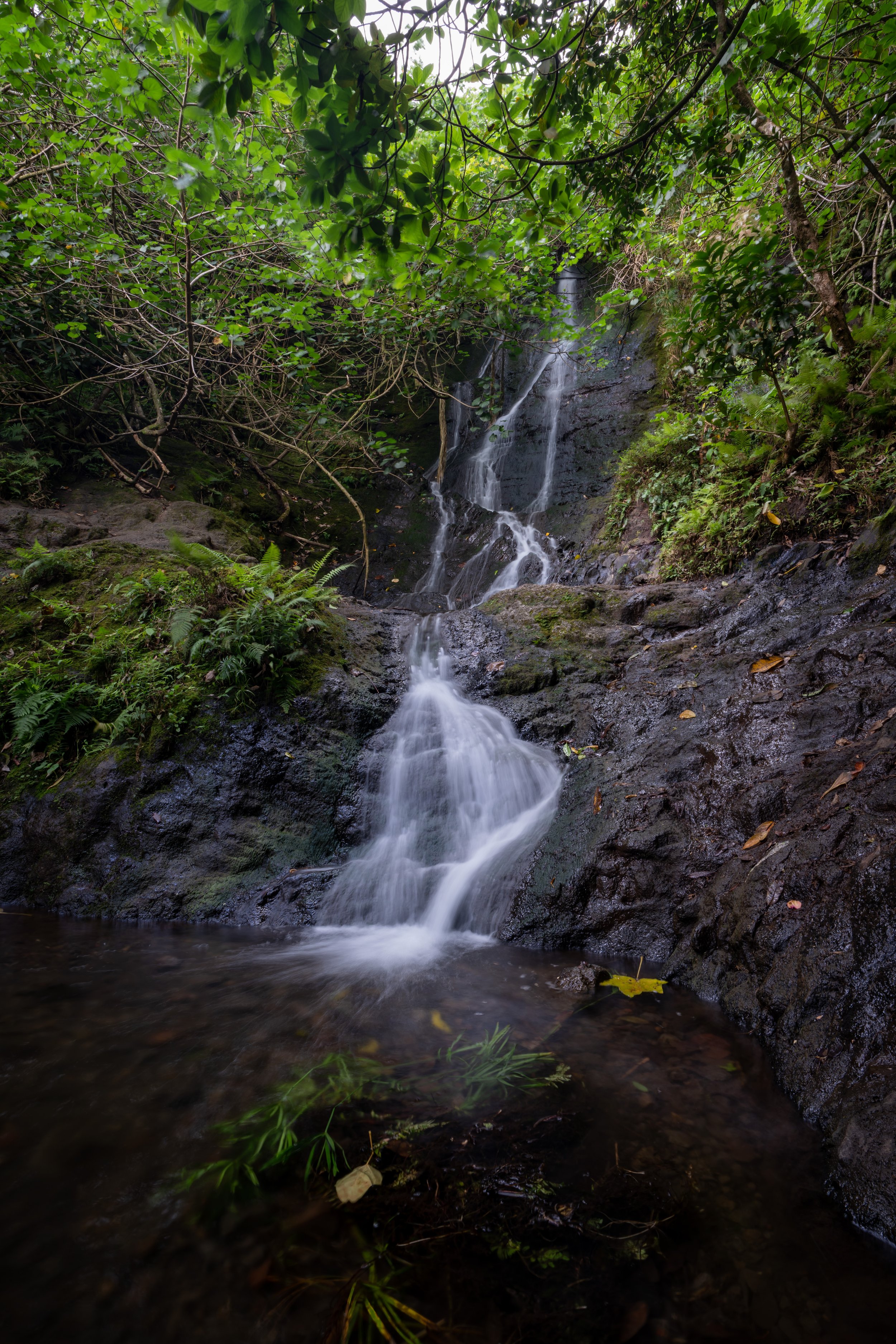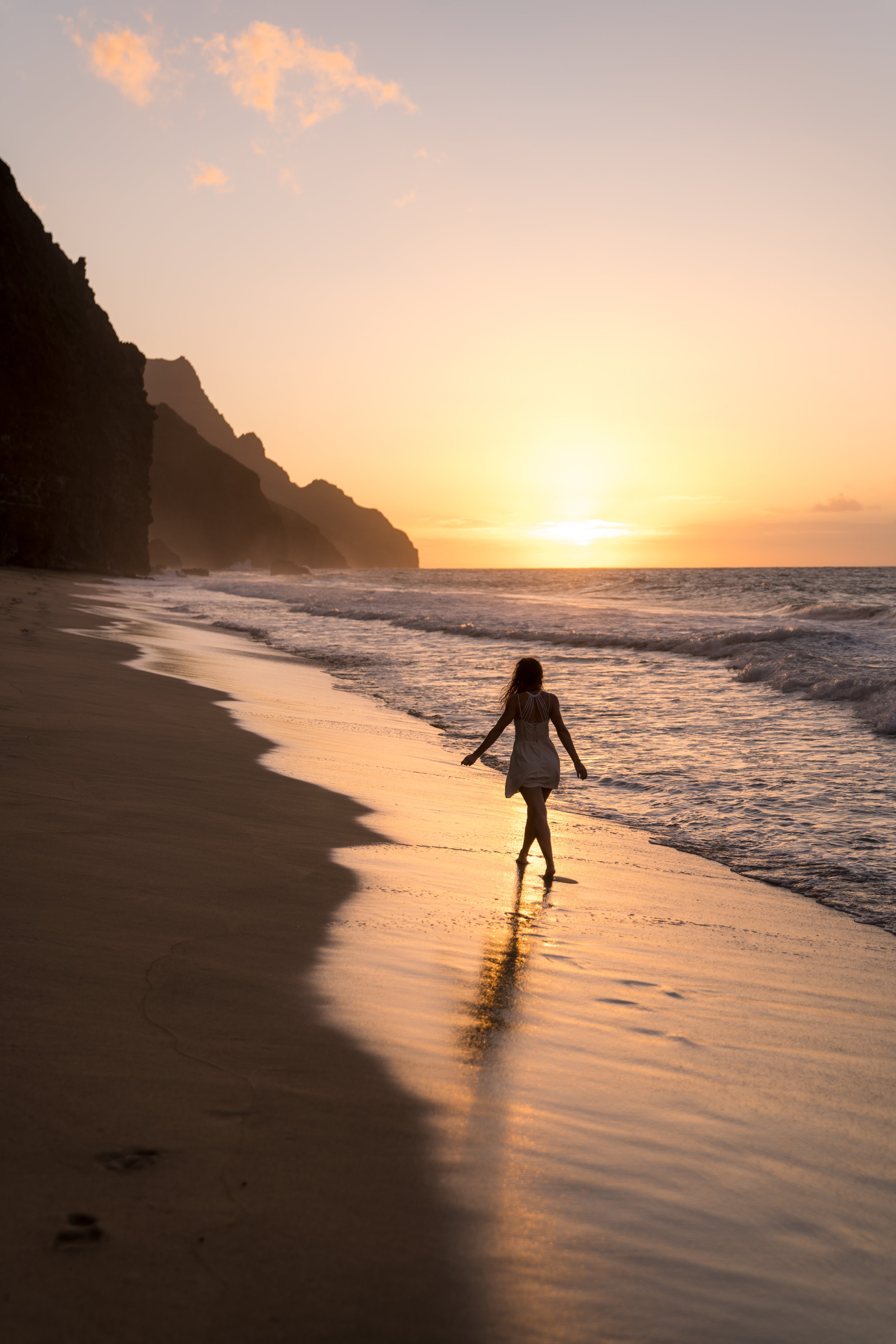Hiking the Makapuʻu Point Lighthouse Trail on Oʻahu, Hawaiʻi
Distance (Roundtrip): 2.5 miles / 4.0 km
The Makapuʻu Lighthouse Trail on the east side of Oʻahu is a popular day hike among both locals and visitors alike, because of its stunning panoramic views that begin shortly after leaving the trailhead and continue all the way to the historic Makapuʻu Lighthouse, perched on the cliffs at the summit!
On top of this, the Makapuʻu Point Lighthouse Trail is also renowned as one of the best and easiest sunrise hikes on Oʻahu, on account of the expansive east-facing views from the top that can be reached in a relatively short time, as the entirety of the trail to the summit is paved!
All this to say, the Makapuʻu Lighthouse Trail is one of the best kid-friendly trails on Oʻahu, and if you’re interested in learning about even more great hikes to do with young kids on the island, I highly recommend checking out my separate article linked below.
Read My Separate Post: Best Kid-Friendly Hikes on Oʻahu
Makapuʻu Lighthouse Shuttle
If you don’t have transportation or would like to learn about the hike from a guide, I highly recommend booking the tour below. This is easily the cheapest shuttle to the Makapuʻu Lighthouse Trail, and the tour provides roundtrip transportation from your hotel in Waikīkī.
Additionally, one of my favorite things about booking through Viator is the reserve-now-and-pay-later option. As long as you’re booking more than three days in advance, you have the option to book ahead and cancel in the future if you change your mind.
Makapuʻu Lighthouse Trailhead Parking
Parking for the Makapuʻu Lighthouse Trailhead is located in a paved parking lot off of Kalanianaʻole Hwy in east Honolulu.
However, finding parking can be tough on any given day of the week unless you hike early in the day. This is especially true midday on weekends, and you may need to park up to 0.5 miles (0.8 km) away on the highway if you arrive at its busiest.
Out of caution, consider the Makapuʻu Lighthouse parking lot to be a high-crime area for petty theft. Never leave bags or anything valuable in your car.
Google Maps Directions: Makapuʻu Lighthouse Trailhead
My Hawaiʻi Hiking Checklist
Osprey 3L Water Bladder - The Osprey 3L water bladder is the most universal hiking and backpacking water bladder on the market, and it’s my go-to because of the slide-off seal that allows it to be quickly filled from the top. Additionally, individual parts are easily replaceable, such as the bite valve.
Blister / Heel Protectors - I swear by these cheap, amazing heel protectors to prevent blisters for nearly every kind of hiking and backpacking that I do!
Hiking / Trail Running Shoes - Depending on the type of trail, I prefer to use either the Keen Targhee for longer, more rugged hiking or the HOKA Zinal Trail-Running Shoe for lighter, less intense trails. In either case, both have been amazing to me for many years across countless environments, and both can be found in men’s and women’s sizes. - (Men’s Keen / Women’s Keen) (Men’s HOKA / Women’s HOKA)
Sun Shirt w/ Hood - A quality sun shirt can be your best friend on a trail with minimal shade, which can be found in both men’s and women’s sizes.
High SPF Sunscreen - Packing high-SPF sunscreen is a must for long days outside!
Hiking the Makapuʻu Lighthouse Trail
The Makapuʻu Point Lighthouse Trail begins on the paved path at the far end of the parking lot and continues on this path for a little over 1.0 miles (1.6 km).
In total, the hike gains about 500 ft. (152 m) of elevation from the trailhead to the viewpoint at the top.
Makapuʻu-Kaʻiwi Shoreline Junction
This dirt path that leads off the paved trail to the right is the Kaʻiwi Shoreline Trail, and the way to get down to Alan Davis Beach.
In short, the Kaʻiwi Shoreline Trail to Alan Davis Beach makes for a nice, quiet walk down to the secluded beach. However, I don’t think that the 0.5-mile (0.8 km) walk to the beach would be a great spot for young kids, as there are better kid-friendly beaches around the island, such as the nearby Waimānalo Beach.
Read My Separate Post: Kaʻiwi Shoreline Trail
Overall, the Makapuʻu Trail up to the lighthouse at the top is fairly self-explanatory, and if you look off to the sides of the trail, you see native plants, such as ʻIlima, the Hoary Abutilon, Maʻo, and ʻUhaloa in fairly high numbers.
In addition, Molokai, Maui, and Lānaʻi can be seen from the first lookout on the trail, which is the lookout in the photo below.
Makapuʻu Point
From the top, you can see things as close as Makapuʻu Beach all the way to Mokoliʻi and beyond on the clearest of days.
Makapuʻu Tide Pools Trail
For those wondering, the Makapuʻu Tide Pools Trail is a short trail off of the main Makapuʻu Lighthouse Trail to a number of beautiful tide pools down by the water.
That being said, the trail down to the Makapuʻu Tide Pools is short but challenging and steep, and it is not meant for all people, of all abilities. There is a lot of loose rock, and on top of the trail’s inherent difficulty, the coastline can be hazardous when a big swell crashes into the pools.
Read My Separate Post: Makapuʻu Tide Pools Trail
Native Plants on the Makapuʻu Trail
Unfortunately, a low-elevation trail, such as this one, is almost always covered in non-native/ invasive plants. However, as previously mentioned, there are a number of native plants that can be seen, such as Maʻo, ʻUhaloa, Milo, the Hoary Abutilon, and Pāʻū o Hiʻiaka.
If you would like to learn more about these tons of other native Hawaiian plants from across the islands, I encourage you to check out my separate post linked below.
Read My Separate Post: Native Hawaiian Plant Guide
More Oʻahu Adventures
If you’re interested in reading about some more amazing Oʻahu adventures, check out my separate posts below!
Best Hotels & Restaurants in Waikīkī
If you’re trying to decided where to stay on Oʻahu, check out my top 10 list for the best resorts and restaurants in Waikīkī.
I break down what makes one hotel a better choice over another, so that you can find the best fit for your stay on the island.
Read My Separate Post: Best Waikīkī Hotels & Restaurants
HNL Airport-Hotel Shuttle
Prices on ride-share apps like Uber/ Lyft cannot beat the price of booking your hotel shuttle prior to arrival. I say this because there are additional fees for ride-share airport pick-ups at Honolulu Airport (HNL), which is why I recommend booking your transportation in advance using the options below.
Additionally, the last option below will go as far as the Ko ʻOlina Resorts on the West Side and Turtle Bay on Oʻahu’s North Shore!
Best Way to Book Rental Cars!
I travel quite a bit, and I know firsthand that finding a good rental car deal can be a challenge, but that’s why I recommend comparing all of your options with Discover Cars.
In short, Discover Cars is a well-known, reputable business that allows you to search for the best deal across companies, and they have the best full-refund cancellation policy I’ve ever seen, valid up to 72, or sometimes even 48, hours prior to your reservation!
Book Here: Discover Cars
Visiting Other Islands
If you are visiting Oʻahu or heading to another island, check out some of my personal recommendations for Oʻahu, Maui, Kauaʻi, Molokai, Lānaʻi, and Hawaiʻi Island (Big Island) in these separate posts.
If you’re trying to decide which island is right for your visit, check out my overview about each island in the post below.
Read My Separate Post: What is the Best Hawaiian Island to Visit?
What is the Best Time of Year to Visit Hawaiʻi?
The weather in Hawaiʻi can often appear to be warm and beautiful throughout the year, but in my experience, there is a lot more to consider when planning what time of year to visit the islands, such as what island you are considering, what sides of each island do you plan to stay, what activities are you most interested in, the wildlife, and countless other nuanced variables that can all impact the type of trip you can expect to have.
For these reasons, I highly recommend reading through my separate article to not only understand my thoughts regarding the best time of year to come to Hawaiʻi but also what you need to consider based on the time of year that you plan to visit.
Read My Separate Post: What is the Best Time of Year to Visit Hawaiʻi?
10 Best Tours & Excursions on Oʻahu
There are a lot of different tour options to choose from on Oʻahu, but to make it easier to decide, I made a list of my favorite tours because some things simply are better with a local guide!
Read My Separate Post: Best Tours on Oʻahu
Safety
All hikes in Hawaiʻi should not be compared to trails outside of the islands, and hikers should exercise due caution on every adventure, given that many are extremely dangerous.
By this, I mean that Hawaiʻi is known for hot, humid weather, steep, dramatic, and unstable cliffs, and flash floods, which can occur without warning. Therefore, it is important that you check the local forecast, understand the physical condition of your entire group, and pack sufficient food and water before attempting any adventure.
Disclaimer
All information provided on this blog is for informational purposes only and is not intended to be a substitute for information or advice from qualified professionals or managing agencies.
Noah Lang Photography LLC makes no representations or warranties regarding the accuracy or completeness of the information provided here, and readers should use their own discretion, judgement, and seek professional advice where it is appropriate.
Furthermore, Noah Lang Photography LLC shall not be held responsible for any injuries, lost individuals, or legal issues arising from the use of information provided on this website, and if applicable, the above safety disclaimer should be referenced to provide a generic overview of the risks involved.
All said, the content on this blog is for the sole use of Noah Lang Photography LLC, and unauthorized use or reproduction of this content is strictly prohibited.
Disclosure
This post is not sponsored.
However, some of the links in this post are affiliate links, which means that I may earn a small commission if a purchase is made through one of those links. This commission comes at no additional cost to you, and I only recommend products that I personally use and believe will add value to my readers. Thank you for your support, which enables me to continue creating more!
To read the full privacy policy, click here.

About This Blog
Noah Lang Photography, also known as @noahawaii, is 100% reader-supported!
I do not accept guest articles or sponsored content of any kind on my blog, which is why, if you enjoy the outdoor and travel content I create, please consider buying me a coffee!
I appreciate your support, which helps me continue to keep this blog alive!





























